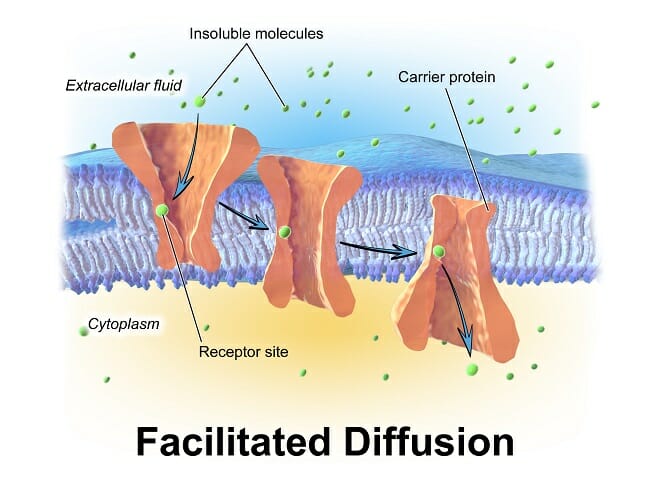Describe Facilitated Diffusion Of Ions Through Channel Proteins
A channel protein a type of transport protein acts like a pore in the membrane that lets water molecules or small ions through quickly. Carrier proteinsand channel proteins.
Facilitated Diffusion Definition Principle Factors Examples
Describe the role of a carrier protein in facilitated diffusion.

Describe facilitated diffusion of ions through channel proteins. These transmembrane proteins form a water-filled channel through which the ion can pass downits concentration gradient. These channels are specific to each ion. Opens and closes according to the needs of the cell.
Facilitated diffusion uses integral membrane proteins to move polar or charged substances across the hydrophobic regions of the membrane. While the chemicals are still moving in the direction of their concentration from high to low they are given a passageway through the cell membrane. Water channel proteins aquaporins allow water to diffuse across the membrane at a very fast rateIon channel proteins allow ions to diffuse across the membrane.
Facilitated diffusion therefore allows polar and charged molecules such as carbohydrates amino acids nucleosides and ions to cross the plasma membrane. Channels are hydrophilic ions allow water to pass through. Channel proteins gated channel proteins and carrier proteins are three types of transport proteins that are involved in facilitated diffusion.
Facilitated diffusion is the diffusion of solutes through transport proteins in the plasma membrane. Facilitated diffusion is a membrane transport method by which molecules move across the plasma membrane through the concentration gradient with the aid of transmembrane proteins. However not all facilitated diffusion is carried out by channel proteins.
Facilitated diffusion is the passive movement of molecules across the cell membrane via the aid of a membrane protein It is utilised by molecules that are unable to freely cross the phospholipid. Facilitated diffusion of ions takes place through proteins or assemblies of proteins embedded in the plasma membrane. Describe what a Channel protein does in facilitated diffusion.
In other cases the protein changes shape allowing molecules to pass through. Facilitated Diffusion Facilitated diffusion involves the use of a protein to facilitate the movement of molecules across the membrane. Channel proteins can aid in the facilitated diffusion of substances by forming a hydrophilic passage through the plasma membrane through which polar and charged substances can pass.
Facilitated diffusion is the diffusion of solutes through transport proteins in the plasma membraneFacilitated diffusion is a type of passive transport. This allows them to move at near diffusion speeds. Channel proteins carry out the majority of facilitated diffusion.
The type of protein located on the membrane of the cell used for the transportation of ions is called an ion channel. Describe one example of facilitated diffusion through a protein channel. Since the transport of molecules occurs through the concentration gradient facilitated diffusion does not use cellular energy for the transport of molecules.
Molecules with pores with polar groups. Two classes of proteinsthat mediate facilitated diffusionare generally distinguished. Channel proteins gated channel proteins and carrier proteins are three types of transport proteins that areinvolved in facilitated diffusion.
Why do these processes. They have pores to allow the passage. Describe the processes of simple diffusion diffusion of ions using channel proteins and facilitated diffusion.
- Facilitated diffusion involves channel andor carrier proteins was active transport only involves carrier proteins - Facilitated diffusion does not use ATPis passive was active transport uses ATP - Facilitated diffusion takes place down a concentration gradient was active transport can occur against a concentration gradient. In some cases molecules pass through channels within the protein. Allows diffusion of larger polar molecules across the membrane.
Facilitated diffusion in cell membrane showing ion channels and carrier proteins Facilitated diffusion also known as facilitated transport or passive-mediated transport is the process of spontaneous passive transport as opposed to active transport of molecules or ions across a biological membrane via specific transmembrane integral proteins. The transmembrane channels that permit facilitated diffusion can be opened or closed.
3 23 Diffusion Active Transport And Membrane Channels Biology Libretexts
Facilitated Diffusion Diffusion Wyzant Lessons
Channel Protein Definition Function Examples Biology Dictionary
Membrane Transport Anatomy And Physiology
Cell Biology Chapter 12 Membrane Transport I Flashcards Quizlet
Difference Between Channel And Carrier Proteins Difference Between
E2 Membrane Transport Flashcards Quizlet
Passive Transport Review Article Khan Academy
Difference Between Channel And Carrier Proteins Difference Between
The Cell Membrane Anatomy And Physiology I
What Is The Role Of Protein Channels In The Cell Membrane Socratic
Simple Diffusion Vs Facilitated Diffusion 11 Differences
Facilitated Diffusion Advanced Ck 12 Foundation
Difference Between Channel And Carrier Proteins Difference Between
Passive Transport Biology For Majors I
Active Transport Review Article Khan Academy
Facilitated Diffusion Definition Examples Quiz Biology Dictionary




Posting Komentar untuk "Describe Facilitated Diffusion Of Ions Through Channel Proteins"